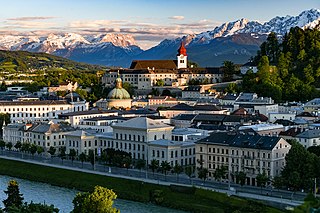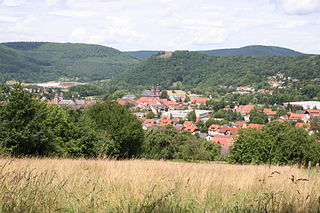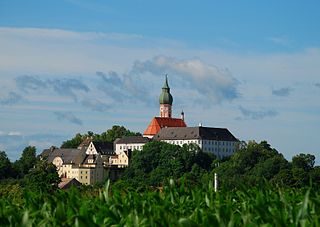
The Hayl family (also spelled Hail) was a German family of organ builders active in Germany, Austria, and Italy from 1591 through 1642. [1]

The Hayl family (also spelled Hail) was a German family of organ builders active in Germany, Austria, and Italy from 1591 through 1642. [1]
The patriarch of the Hayl family was Daniel Hayl the elder (fl. 1591 – c. 1615) who built organs in Germany and Austria in variety locations, including Konstanz Minster (1591–1592), Rheinau Abbey (1592–1594), Ochsenhausen Abbey (1599–1603), Dreifaltigkeitskirche, Kaufbeuren (1604–5), the Cistercian monastery in Stams (1610–12), and Andechs Abbey (1615) among others. [1]
Daniel Hayl the elder had three sons. His son Hans Diepold Hayl was the only one of the three who did not build organs of his own, although he did assist family members in the construction of organs of their design. Daniel Hayl the younger (fl. 1618 – c. 1638) was active as an organ builder in Salzburg, Austria from 1618 through 1638. His most impressive contribution was a very large and impressive organ at Saint Peter's Abbey, Salzburg which he built from 1618 through 1620. [1]
Simon Hayl (fl. 1618 – c. 1642 resided in Polling, Weilheim-Schongau where he built four organs (including at Polling Abbey) from 1621 through 1628. He also built organs in Bolzano, Italy (1618), Wessobrunn Abbey (1624), and parish churches in Prien am Chiemsee (1634) and Lana, South Tyrol (1635–7). His last known work was a repair to the organ at St. Mang's Abbey, Füssen in 1642. [1]

Salzburg is the fourth-largest city in Austria. In 2020, it had a population of 156,852.

Baroque painting is the painting associated with the Baroque cultural movement. The movement is often identified with Absolutism, the Counter Reformation and Catholic Revival, but the existence of important Baroque art and architecture in non-absolutist and Protestant states throughout Western Europe underscores its widespread popularity.

In art history, "Old Master" refers to any painter of skill who worked in Europe before about 1800, or a painting by such an artist. An "old master print" is an original print made by an artist in the same period. The term "old master drawing" is used in the same way.

Amorbach is a town in the Miltenberg district in the Regierungsbezirk of Lower Franconia (Unterfranken) in Bavaria, Germany, with some 4,000 inhabitants. It is situated on the small river Mud, in the northeastern part of the Odenwald.

Andechs Abbey is a Benedictine priory in the municipality of Andechs, in the Landkreis of Starnberg, Upper Bavaria, Germany. A place of pilgrimage on a hill east of the Ammersee, the Abbey is famed for its flamboyant Baroque church and its brewery, Klosterbrauerei Andechs, the proceeds from which help fund the monks' mission of help. Composer Carl Orff is buried in the church.

St Peter's Abbey, or St Peter's Archabbey, is a Benedictine monastery and former cathedral in the Austrian city of Salzburg. It is considered one of the oldest monasteries in the German-speaking area, and in fact the oldest with a continuous history since its foundation in 696.

Rheinau Abbey was a Benedictine monastery in Rheinau in the Canton of Zürich, Switzerland, founded in about 778 and suppressed in 1862. It is located on an island in the Rhine.
Ochsenhausen Abbey was a Benedictine monastery in Ochsenhausen in the district of Biberach in Baden-Württemberg, Germany.

Konstanz Minster or Konstanz Cathedral is a historical building in Konstanz, southern Germany, the proto-cathedral of the former Roman Catholic diocese of Konstanz.

Polling Abbey is a former monastery in Polling bei Weilheim, district of Weilheim-Schongau, in Upper Bavaria, Germany.

The Racovian Academy was a Socinian school operated from 1602 to 1638 by the Polish Brethren in Raków, Sandomierz Voivodeship of Lesser Poland. The communitarian Arian settlement of Raków was founded in 1569 by Jan Sienieński. The academy was founded in 1602 by his son, Jakub Sienieński. The zenith of the academy was 1616–1630. It was contemporaneous with the Calvinist Pińczów Academy, which was known "as the Sarmatian Athens". It numbered more than 1,000 students, including many foreigners. At this point it is estimated that ten to twenty percent of Polish intellectuals were Arians.
Roger de Piles's L'Abrégé de la vie des peintres...avec un traité du peintre parfait was a major art biography of painters. It was written by the French spy Roger de Piles. In 1692, during the War of the League of Augsburg, he was arrested in the Hague carrying a false passport and imprisoned for the next five years, where he wrote his L'Abrégé in 7 parts; 1) Sketch of the perfect painter, 2) Greek painters; 3) Painters from Rome & Florence; 4) Painters from Venice; 5) Painters from Lombardy; 6) Painters from Germany and the Low Countries; 7) Painters from France and ending with his famous "Balance of painters". The book was finally published in 1699 following his appointment as Conseiller Honoraire to the Académie de peinture et de sculpture in Paris.
Gheerart Janssen, later known as Gerard Johnson Sr., an English sculptor who operated a monument workshop in Elizabethan and Jacobean England and the father of Gerard Johnson the younger, who is thought to have created Shakespeare's funerary monument. He and Cornelius Cure became the leaders of the so-called Southwark school of monument design, which dominated the English market in the late-sixteenth century.

Benjamin Culme (1581-1657), Doctor of Divinity, was an English Anglican clergyman who served as Dean of St Patrick's Cathedral, Dublin, Ireland, from 1625 until 1649.